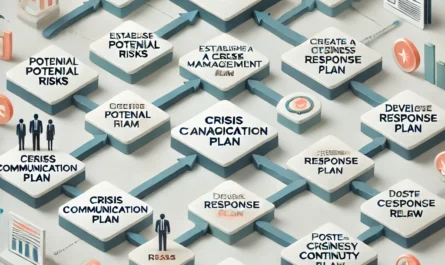A well-thought-out crisis management strategy is a critical component of business success and sustainability. Every business, no matter how prepared it might seem, can face unexpected challenges ranging from natural disasters to financial crises or even a data breach. The key to overcoming these challenges is having a proactive and comprehensive plan that mitigates risks, protects the business, and allows for swift recovery.
In a world where risks are becoming more complex and interconnected, knowing how to create a crisis management strategy for your business can ensure you’re ready to tackle crises head-on. An effective strategy is more than just a contingency plan; it’s an integrated part of a company’s DNA that encompasses communication, risk assessment, and long-term planning.
Understanding the Importance of Crisis Management
Crisis management is not just about responding to challenges but preparing for them in advance. When a business is unprepared, the fallout from a crisis can lead to long-term damage, including financial loss, operational disruptions, and even reputational harm. Conversely, a solid crisis management strategy enables a business to react swiftly, maintain operations, and protect its brand image.
Moreover, managing crises effectively builds confidence among stakeholders—whether employees, customers, or investors—that the business can navigate turbulent times. A well-prepared business can not only survive but thrive post-crisis by demonstrating resilience and adaptability.
Defining Crisis in a Business Context
In the business world, a crisis is any event that disrupts normal operations and puts the company’s survival at risk. These events can be categorized into various types, such as:
- Operational Crises: System breakdowns, supply chain disruptions, or key personnel loss.
- Financial Crises: Cash flow problems, economic downturns, or market crashes.
- Reputational Crises: Public relations disasters, product recalls, or legal issues.
- Technological Crises: Cybersecurity breaches, data theft, or technology failures.
- Natural Disasters: Hurricanes, earthquakes, or pandemics disrupting normal business activities.
Understanding these potential crises helps businesses identify which ones are most relevant to their industry, location, and operations, so they can plan accordingly.
Key Elements of a Crisis Management Strategy
A robust crisis management strategy consists of several vital components that ensure a coordinated response. These include:
- Risk Assessment: Identifying potential threats that could disrupt operations.
- Crisis Response Plan: Establishing protocols and procedures to follow during a crisis.
- Crisis Communication Plan: Ensuring clear communication internally and externally.
- Crisis Response Team: Assigning roles and responsibilities to handle the crisis.
- Monitoring Systems: Keeping an eye on indicators that may signal a crisis.
- Post-Crisis Review: Evaluating what worked and what didn’t to improve future responses.
A good crisis management strategy integrates these elements to form a cohesive approach to managing crises from beginning to end.
Risk Assessment: Identifying Potential Crises
Every business should start by conducting a risk assessment to identify the types of crises that are most likely to affect them. This process involves looking at internal and external risks, analyzing past incidents, and considering industry trends.
Some common methods to conduct a risk assessment include:
- SWOT Analysis (Strengths, Weaknesses, Opportunities, and Threats)
- Scenario Planning: Predicting the impact of potential crises.
- Risk Mapping: Creating visual representations of where the most significant risks lie.
Once the risks are identified, businesses can prioritize them based on the likelihood of occurrence and the potential impact on the organization.
Developing a Crisis Communication Plan
Effective communication during a crisis can make or break a company’s response. A well-structured crisis communication plan should outline how information will be disseminated to employees, stakeholders, the public, and the media.
Key elements of a communication plan include:
- Chain of Command: Establish who is responsible for communication during the crisis.
- Messaging Templates: Pre-prepared messages to ensure consistency.
- Media Strategy: Deciding how and when to involve the press.
- Stakeholder Outreach: Keeping investors, customers, and partners informed.
Internal communication is just as important as external communication, ensuring employees are kept in the loop and can contribute to a coordinated response.
Roles and Responsibilities in Crisis Management
An essential part of any crisis management strategy is clearly defining the roles and responsibilities of individuals within the organization. A typical crisis response team might include:
- Crisis Manager: The person in charge of overseeing the entire response effort.
- Spokesperson: The individual responsible for communicating with the media and public.
- Department Heads: Leaders who ensure their teams are aligned with the overall strategy.
- Legal Counsel: To provide guidance on compliance and liability issues.
- Public Relations Team: To manage the company’s image and reputation.
Each team member should have a clear understanding of their role and how they contribute to the overall crisis response.
Training and Simulation for Crisis Preparedness
Regular training and crisis simulations are necessary to ensure the crisis management plan works in practice. These simulations should be as realistic as possible, testing different scenarios and putting the crisis team through its paces. This practice not only improves the team’s response but also highlights any weaknesses in the plan that need to be addressed.
Moreover, training ensures that all employees are familiar with the basic procedures during a crisis, such as evacuation plans, communication protocols, and safety measures.
Establishing a Crisis Response Team
The crisis response team is at the heart of any crisis management strategy. It is essential to assemble a diverse team of experts from different departments, ensuring all aspects of the business are covered. Key considerations for establishing a crisis response team include:
- Cross-Functional Representation: Include representatives from finance, operations, human resources, IT, and communications.
- Decision-Making Authority: The team must have the authority to make critical decisions quickly.
- Leadership: Identify a crisis leader who will take charge of directing the response efforts.
The response team should meet regularly to review the crisis plan and make updates based on new risks or lessons learned.
You can also read; How to Build Strategic Partnerships for Business Expansion
Creating a Crisis Response Plan
A crisis response plan is a detailed document that outlines the steps the company will take in the event of a crisis. It should include:
- Emergency Procedures: What actions to take immediately after a crisis occurs.
- Communication Protocols: Who to inform, how, and when.
- Crisis Response Team Roles: Defining the responsibilities of each team member.
- Recovery Steps: A plan for returning to normal operations once the crisis is under control.
This plan should be easily accessible, and all employees should be familiar with its contents.



